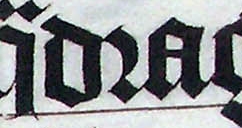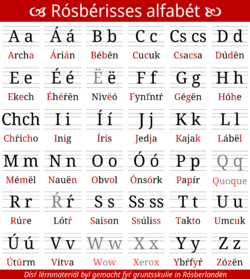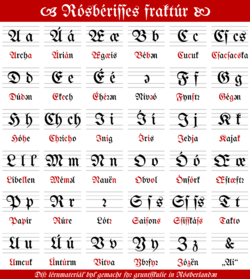Walnerian orthography
The Walnerian orthography (Walnerian: Rósbérisse ortografie; in blackletter Rósbériſſe ortografie) is a set of rules, that guide the written form of the Walnerian language.
Alphabet
| Walnerian alphabet Rósbérisses alfabét Rósbériſſes aľfabét | |
|---|---|
 First ever Walnerian printing press, 1650's | |
| Type | Alphabet
|
| Languages | |
Parent systems | Latin script
|
| A a /a ~ ɑ/ |
Á á /aː ~ ɑː/ |
B b /b/ |
C c /t͡s/ |
Cs cs /t͡ʃ/ |
D d /d/ |
E e /ɛ ~ e/ |
É é /ɛː ~ eː/ |
Ë ë /ə ~ ◌̩/ |
F f /f/ |
| G g /ɡ/ |
H h /ɦ ~ h/ |
Ch ch /x/ |
I i /i ~ ɪ/ |
Í í /iː ~ ɪː/ |
J j /j/ |
K k /k/ |
L l /l/ |
M m /m/ |
N n /n/ |
| O o /ɔ ~ o/ |
Ó ó /ɔː ~ oː/ |
P p /p/ |
Q q /kv/ |
R r /r/ |
Ŕ ŕ /ʁ̩ ~ ə/ |
S s /s/ |
Ss ss /ʃ/ |
T t /t/ |
U u /u/ |
| Ú ú /uː/ |
V v /v/ |
W w /w/ |
X x /ks/ |
Y y /y ~ yː/ |
Z z /z/ |
Historical development
From a historical digraph alphabet, the script developed from the Early New High Dolch orthographies. The changes either follow the phonetic shifts (for example the phonetical shifts from /æ/ and /œ/ to /ɛː/, or shift from /a͡u/ to /ɔː/).
Changes in orthography without the phonetical shift include:
- SS/ẞ → S
- S → Z
- Z → C
- Ü → Y
Later in the mid 17th century, accute was introduced for the long vowels, replacing the digraphs:
- IE/IH/II → Í
- AH/AA → Á
- EH/EE → É
- OH/OO → Ó
- UH/UU → Ú
Current usage
R Accute
Ŕ ŕ
The letter R Accute (Ŕ) was introduced in early 19th century, replacing the digraph ER in cases, where the phonological shift /əˑʀ/ → /ʁ̩ ~ ə/ happened.
Digraphs
There are three digraphs in the Walnerian language (CS for /t͡ʃ/, CH for /x/, SS for /ʃ/). They are a remnant of the old digraph orthography and some people support their replacement with diacritic characters. The most popular of those proposal suggests replacing the digraphs with circumflexed letters C, H and S, possibly being inspired by Esperanto, which gained popularity in Walneria in mid 1950's.
- Cs cs → Ĉ ĉ
- Ch ch → Ĥ ĥ
- Ss ss → Ŝ ŝ
E Diaeresis
Ë ë
The letter E Diaeresis (Ë) was introduced around the same time as the Accuted R (Ŕ), replacing the letter E in endings and other syllables, where it either became silent and another sound became syllabic, or the /ɛ/ sound was reduced to /ə/. The most common example may be the -ën ending in the infinite forms of the verbs. Examples of the words including multiple syllabic letters may be:
- Lófën (English: "To run", IPA: /lɔːfn̩/)
- Ézël (English: "Donkey", IPA: /ɛːzl̩/)
- Róbë (English: "Seal", IPA: /rɔːbə/)
S vs. SS
Ss ss
In front of the letters P, T, if in the first syllable of a word, or a word compound, the letter SS, representing the /ʃ/ sound is written only as a S. Examples of the orthography may include:
First syllable of a word
Other syllables of a word
First syllables of a coumpound word
- Hópstodál (English: "Capital city", IPA: /ɦɔːpʃtɔdaːl/)
- Baispíl (English: "Example", IPA: /bɑjʃpiːl/)
J vs. I
J j
For the sound /j/ behind a vowel, letter I is used instead of a J (That means that in -AJ- should be replaced with -AI-). This rule doesn't apply to the compound words or words of a foreign origin:
- Cvissjár (English: "Year in between")
- De júre (English: "By the law", or simply de jure)
- Ainikait (English: "Uniquity")
Allography
Ꞓꞓ Ħħ Ꞩꞩ
The modern Walnerian orthography allows allographic forms for digraphs:
- C with bar for digraph CS
- S with an oblique stroke for digraph SS. If in fraktur, a stroked variant of long S also may be used, creating the set of Ꞩẜꞩ
- H with stroke for digraph CH
Two out of those three digraphs are commonly used in the Jalov dialect.
Fraktur orthography
| Walnerian fraktur alphabet Rósbérisses fraktúr alfabét Rósbériſſes fraktúr aľfabét | |
|---|---|
 Example of R rotunda (ꝛ) in a word | |
| Type | Alphabet
|
| Languages | |
Parent systems | Latin script
|
| This section includes blackletter characters | |
| - Please check if you have the font UnifrakturMaguntia installed - |
In the case Walnerian language is to be written in Fraktur, there are a bit different rules to orthography, creating the Walnerian Fraktur Orthography (Walnerian: Rósbérisses fraktúr ortografie; in blackletter Rósbériſſes fraktúr ortografie), which guides the rules only for if the font is of the blackletter family.
Contrary to the popular opinion, the Fraktur Orthography is not the older Zusamëlfasunk orthography, but developed from it independently relative to the main Walnerian orthography.
| A a /a ~ ɑ/ |
Á á /aː ~ ɑː/ |
Æ æ /ɛː ~ æː/ |
B b /b/ |
C c /t͡s/ |
Cſ cſ cs /t͡ʃ/ |
D d /d/ |
E e /ɛ ~ e/ |
É é /ɛː ~ eː/ |
Ə ə /ə ~ ◌̩/ |
| F f /f/ |
G g /ɡ/ |
H h /ɦ ~ h/ |
Ch ch /x/ |
I i /i ~ ɪ/ |
Í í /iː ~ ɪː/ |
J j /j/ |
K k /k/ |
L l ľ /l/ |
M m /m/ |
| N n /n/ |
O o /ɔ ~ o/ |
Ó ó /ɔː ~ oː/ |
Œ œ /ɛː ~ œː/ |
P p /p/ |
Q q /kv/ |
R r /r/ |
ꝛ ꝛ /ʁ̩ ~ ə/ |
S ſ s /s/ |
Sſ ſſ ſs /ʃ/ |
| T t /t/ |
U u /u/ |
Ú ú /uː/ |
V v /v/ |
W w /w/ |
X x /ks/ |
Y y /y ~ yː/ |
Z z /z/ |
Main difference from the main orthography is the preservation of the long S (ſ/ſ), vowel shift denotation symbols for shifts Ä→É (Æ/Æ) and Ö→É (Œ/Œ), usage of turned e (ə/ə) instead of ë, two miniscule versions of the letter L (ľ;l) and preservation of R rotunda (ꝛ/ꝛ) rather than introducing ŕ.
Long and rounded S
The Fraktur orthography still uses both long and rounded S letters as a miniscule.
The rules on writing those are:
- Long S (ſ/ſ) is written, if it is on the beginning or in the middle of a syllable
- Rounded S (s/s) is written on the end of a syllable or if they act as a syllabic consonant
Both rounded S (s) & long S (ſ), if capitalizated, are written as a regular S
This applies to both digraphs including the letter S (Cſ/Cs & Sſ/Ss). Long S (ſ) is used again in the case, that the digraph stands on the beginning or the middle of a syllable, while Rounded S (s) is used if the digraphs stands on the end of a syllable or is syllabic.
The digraph ſs/ss always uses the long S for the initial letter of the digraph, creating variants:
- Ss - For alone standing digraph Ss
- Sſ - For the initial capitalised digraph Ss
- ſſ - For the initial or medial letter of a syllable
- ſs - For the finial letter of a syllable
Variants of the É
Besides the regular Éé/Éé, there are two more letters, the letter Ææ/Ææ, which stands in the places, where the sound is equivalent version to the Dolch sound Ä, and the letter Œœ/Œœ, which stands in the places, where the sound is equivalent version to the Dolch sound Ö. Those letters were used commonly in the regular orthography until mid 18th century.
Hard and soft L
The Fraktur orthography still uses both soft blackletter miniscule l (l) and hard blackletter miniscule l (ľ). It was originally taken from the Yasic soft and hard L rules, but eventually merged with other rules, simplifying it:
The rules on writing those are:
- Soft L (l) is written before the vowels or if the letter is syllabic (that means, behind ə/ë)
- Hard L (ľ) is written before consonants or on the end of the world
Comparison of the two orthographies
| Order | 1 | 2 | 3 | 4 | 5 | 6 | 7 | 8 | 9 | 10 | 11 | 12 | 13 | 14 | 15 | 16 | 17 | 18 | 19 | 20 | 21 | 22 | 23 | 24 | 25 | 26 | 27 | 28 | 29 | 30 | 31 | 32 | 33 | 34 | 35 | 36 | |||||||
|---|---|---|---|---|---|---|---|---|---|---|---|---|---|---|---|---|---|---|---|---|---|---|---|---|---|---|---|---|---|---|---|---|---|---|---|---|---|---|---|---|---|---|---|
| Normal | Majuscule | A | Á | B | C | Cs | D | E | É | Ë | F | G | H | Ch | I | Í | J | K | L | M | N | O | Ó | P | Q | R | Ŕ | S | Ss | T | U | Ú | V | W | X | Y | Z | ||||||
| Minuscule | a | á | b | c | cs | d | e | é | ë | f | g | h | ch | i | í | j | k | l | m | n | o | ó | p | q | r | ŕ | s | ss | t | u | ú | v | w | x | y | z | |||||||
| Fraktur | Majuscule | A | Á | B | C | Cſ | Cs | D | E | É | Æ | Œ | Ə | F | G | H | Ch | I | Í | J | K | L | M | N | O | Ó | P | Q | R | Ꝛ | S | Sſ | Ss | T | U | Ú | V | W | X | Y | Z | ||
| Minuscule | a | á | b | c | cſ | cs | d | e | é | æ | œ | ə | f | g | h | ch | i | í | j | k | l | ľ | m | n | o | ó | p | q | r | ꝛ | ſ | s | ſſ | ſs | t | u | ú | v | w | x | y | z | |
| IPA Sound | a ɑ |
aː ɑː |
b | t͡s | t͡ʃ t͡ɕ |
d | ɛ e |
ɛː eː |
ə ◌̩ |
f | ɡ | h ɦ |
x | i ɪ |
iː ɪː |
j | k | l | m | n | ɔ o |
ɔː oː |
p | k͡v | r | ʁ̩ ə |
s | ʃ ɕ |
t | u | uː | v | w ɰ |
k͡s | y yː |
z | |||||||
Marcation of Anglish in Walnerian
Th th ᵺ
Walnerian-Anglish dictionary includes few notable characters in the translations, most notably:
- A line below for the primary stress (as the stress is always on the first syllable in Walnerian proper).
- Example: „Wh̩at w̩as ᵺ̩e obs̩ession ab̩out“
- Slash through the miniscule th (making it a ᵺ) for the cases where the letter denotes the voiced dental fricative [ð], to distinguish it from the voiceless dental fricative [θ].
- Example: „I̩ th̩ink ᵺ̩at ᵺ̩is th̩ing m̩ay b̩e ᵺ̩eirs“
- Breve below silent letters, helping to denote them as not being pronounced (only for consonants), the digraph gh is written with a connecting single breve (making it a g͜h).
- Example: „Th̩e ḫo̩norary c̩lass h̩ad t̩oo m̩any s̩ub̮tle th̩oug͜htful a̩nsw̮ers“
So the word "though" (RP: /ðəʊ/; GA: /ðoʊ/) would be found in the dictionary produced in Walneria as "ᵺ̩oug͜h"

